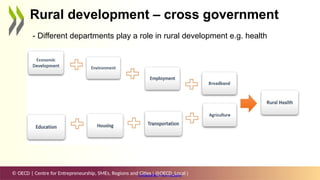OECD Rural Principles series: Taking an integrated approach to Rural Development – B-A. Bryce.
- 1. @OECD_local www.linkedin.com/company/oecd-local www.oecd.org/cfe Rural Proofing – supporting an integrated approach to rural development 14 November 2024 Betty-Ann Bryce, Policy Analyst/Rural Policy Coordinator, Centre for Entrepreneurship, SME’s and Cities, OECD
- 2. Unclassified - Non classifié Rural Proofing Lessons from OECD countries © OECD | Centre for Entrepreneurship, SMEs, Regions and Cities | @OECD_Local | The OECD working paper in collaboration with the WHO Rural Proofing: Lessons from OECD countries and potential application to health July 2024. Draws on lessons from different OECD member countries to:  Explore how more robust rural proofing models can be developed  Develop a roadmap for more effective rural proofing mechanisms.
- 3. Unclassified - Non classifié Rural Proofing Lessons from OECD countries © OECD | Centre for Entrepreneurship, SMEs, Regions and Cities | @OECD_Local | …it continues to grow in relevance as a mechanism to support policies that will have a direct or indirect impact on rural regions. Loved Hated
- 4. © OECD | Centre for Entrepreneurship, SMEs, Regions and Cities | @OECD_Local | Reviewing policies  It is not a policy; it is a process or a policy support resource, a tool that is meant to support policymaking.  It can enable policymakers particularly those who are less familiar with rural areas or issues to make informed decisions
- 5. © OECD | Centre for Entrepreneurship, SMEs, Regions and Cities | @OECD_Local | Rural Proofing – how does it work?  Three pillars:  Gathering evidence  Involving stakeholders  Delivering Information  Outputs should be  clear,  concise, and  timely
- 6. Unclassified - Non classifié Rural development – cross government © OECD | Centre for Entrepreneurship, SMEs, Regions and Cities | @OECD_Local | - Different departments play a role in rural development e.g. health
- 7. Unclassified - Non classifié Core: Rural Proofing Evidence -- best available information that clearly helps policymakers understand the implications of potential impact of policy decisions in rural areas.
- 8. Unclassified - Non classifié State of rural – sample © OECD | Centre for Entrepreneurship, SMEs, Regions and Cities | @OECD_Local |
- 9. Unclassified - Non classifié Develop sophisticated rural intelligence © OECD | Centre for Entrepreneurship, SMEs, Regions and Cities | @OECD_Local | Potential Impact of the proposed policy action Value added of rural Type: data specific to the policy action e.g., climate change, transportation Purpose: provide guidance on the potential impact of that specific action on rural areas When should it be used: also in the early stages, when working with lead agency on the policy action. Type: data on the links between rural and the department specific policy objectives Purpose: show the benefits of working with rural communities When should it be used: (1) rural proofer or lead agency does not see why they need to work with rural areas. (2) to help to show rural in a different light – changes the rural narrative from negative to positive
- 10. © OECD | Centre for Entrepreneurship, SMEs, Regions and Cities | @OECD_Local | Rural Proofing – collaboration  Experts/institutions: Provide technical knowledge  Helps to build capacity and knowledge on rural issues.  Improves rural data collection  They can help to develop rural proofing tools  Help to ensure they aren’t overly complex.  Helps to underpin the narrative of rural from negative to positive – places of opportunity
- 11. © OECD | Centre for Entrepreneurship, SMEs, Regions and Cities | @OECD_Local | Rural Proofing – collaboration and participation  Citizen engagement can help combine pragmatic government approach with other types of knowledge to increase relevance and impact:  Support and inform the development of tools  Helps with communication, buy-in and managing expectations.  Is there a channel to engage with rural stakeholders?  Is it set up, early enough in the process to inform guidance?
- 12. Unclassified - Non classifié Rural Proofing – Rural proofer © OECD | Centre for Entrepreneurship, SMEs, Regions and Cities | @OECD_Local | Consider the “end user” – the rural proofer . Public servants are often responsible for "rural proofing," • overburdened and under- resourced. • rural proofing may involve extra steps and activities that could be seen as burdensome, • involving public servants in the design process will facilitate buy-in and tools that make sense for them .
- 13. Unclassified - Non classifié Factors that could increase the effectiveness of rural proofing © OECD | Centre for Entrepreneurship, SMEs, Regions and Cities | @OECD_Local | 6. Consider the context, if rural proofing is new maybe a targeted issue is more suitable than an all of government approach 7. Design the rural proofing model with the public servant “end user” in mind 8. Encourage the collection of different types of data to support rural proofing 9. Be flexible – there is no one size fits all rural proofing model 10.Measure success but set realistic expectations 1. Develop clear objectives and tailored supporting tools 2. Adopt a “pilot study” approach – learn from sub-optimal short-term results 3. Build a model that is less dependent on political commitment over time 4. Change the rural narrative – from negative “rural needs help” to positive “” “rural is a place of untapped opportunities”
- 14. Thank you!  Betty-Ann.Bryce@oecd.org Twitter: @OECD_local LinkedIn: www.linkedin.com/company/oecd-local Website: www.oecd.org/cfe














